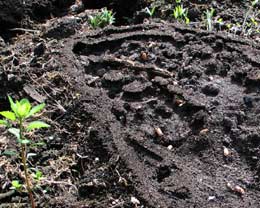
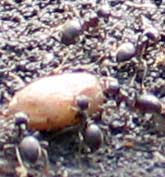 IN
THE GREENHOUSE, I lift up a ceramic container (an old bear-shaped cookie jar
that lost its head years ago) that I keep blood, fish and bonemeal in, and
discover this ants' nest. With the damp soil that we've had
on the raised beds in here recently, as summer storms replenish
the
water
table,
this
must
have
been
a welcome dry area for them to bring the 'ant's eggs', the pupae of the youngsters,
into. The container hadn't been sitting there for long, so they must have been
working hard.
IN
THE GREENHOUSE, I lift up a ceramic container (an old bear-shaped cookie jar
that lost its head years ago) that I keep blood, fish and bonemeal in, and
discover this ants' nest. With the damp soil that we've had
on the raised beds in here recently, as summer storms replenish
the
water
table,
this
must
have
been
a welcome dry area for them to bring the 'ant's eggs', the pupae of the youngsters,
into. The container hadn't been sitting there for long, so they must have been
working hard.
There are mini-plantations of palm tree-like seedlings, just
an inch high, arranged around the ant colony. One of them (left) has
grown enough for me to identify it as a species of spurge (sun
spurge?). Ants enjoy the oil found in spurge seeds. They carry home the seeds,
extract the oil, then dump the seeds near the nest, helping to spread the spurge.
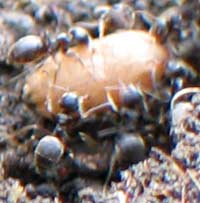
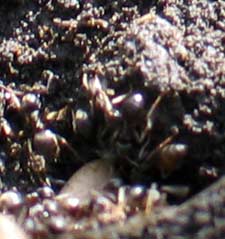 I'm
impressed how soon the workers organise themselves in groups to trundle away
the ants' eggs. By the time I've run indoors for my camera they've cleared
many of them away into the tunnels below.
I'm
impressed how soon the workers organise themselves in groups to trundle away
the ants' eggs. By the time I've run indoors for my camera they've cleared
many of them away into the tunnels below.
I admire the industry of these ants but unfortunately I've got
to relocate them as I'm planting out my tomatoes. I trowel
the nest into a bucket and gently spread it on a nearby veg bed. Hopefully
they'll manage to salvage something from the disaster I've inflicted on them.
A sparrow and later a blackbird pecks away amongst the debris.
As I continue to dig in the raised beds, I find that the colony
extends a couple of feet to the left and up to a foot deep. I disturb winged
ants; the queens and their consorts which will fly off one settled, still,
summer's day (if we have one) to mate prior to the queens starting new colonies.
A few days after I took these photographs, following the heaviest
June rains on record, the whole greenhouse was awash so this colony would soon
have been forced to relocate or drown.
Frogs in the
Flood
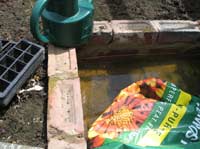
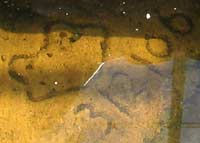 Those
poor ants must feel like extras in a disaster movie as they had a foretaste
of the flooding yesterday. I was about to start work
in the greenhouse
when
I
saw
that the
path was covered
with several
inches
of water (left). This drained away during the day but more was to
come, washing right over the raised beds and out through a gap in the far
corner.
Those
poor ants must feel like extras in a disaster movie as they had a foretaste
of the flooding yesterday. I was about to start work
in the greenhouse
when
I
saw
that the
path was covered
with several
inches
of water (left). This drained away during the day but more was to
come, washing right over the raised beds and out through a gap in the far
corner.
I've got a old header tank in the greenhouse which catches
the water from the roof. Of course this overflowed and this added
to
groundwater
and run-off finding its way in from the garden.
It seems appropriate that when we constructed the raised beds
in the greenhouse last year I marked the date with a frog's face, inscribed
in the concrete (this was a pun, as I'd placed an assortment of recycled
bricks frog-up - a frog being the depression in the face of the brick - so
that the maker's names, mainly local collieries, would be visible).

 IN
THE GREENHOUSE, I lift up a ceramic container (an old bear-shaped cookie jar
that lost its head years ago) that I keep blood, fish and bonemeal in, and
discover this ants' nest. With the damp soil that we've had
on the raised beds in here recently, as summer storms replenish
the
water
table,
this
must
have
been
a welcome dry area for them to bring the 'ant's eggs', the pupae of the youngsters,
into. The container hadn't been sitting there for long, so they must have been
working hard.
IN
THE GREENHOUSE, I lift up a ceramic container (an old bear-shaped cookie jar
that lost its head years ago) that I keep blood, fish and bonemeal in, and
discover this ants' nest. With the damp soil that we've had
on the raised beds in here recently, as summer storms replenish
the
water
table,
this
must
have
been
a welcome dry area for them to bring the 'ant's eggs', the pupae of the youngsters,
into. The container hadn't been sitting there for long, so they must have been
working hard.
 I'm
impressed how soon the workers organise themselves in groups to trundle away
the ants' eggs. By the time I've run indoors for my camera they've cleared
many of them away into the tunnels below.
I'm
impressed how soon the workers organise themselves in groups to trundle away
the ants' eggs. By the time I've run indoors for my camera they've cleared
many of them away into the tunnels below.
 Those
poor ants must feel like extras in a disaster movie as they had a foretaste
of the flooding yesterday. I was about to start work
in the greenhouse
when
I
saw
that the
path was covered
with several
inches
of water (left). This drained away during the day but more was to
come, washing right over the raised beds and out through a gap in the far
corner.
Those
poor ants must feel like extras in a disaster movie as they had a foretaste
of the flooding yesterday. I was about to start work
in the greenhouse
when
I
saw
that the
path was covered
with several
inches
of water (left). This drained away during the day but more was to
come, washing right over the raised beds and out through a gap in the far
corner.